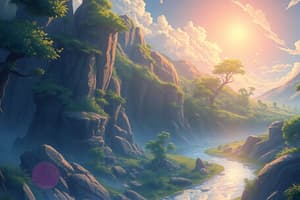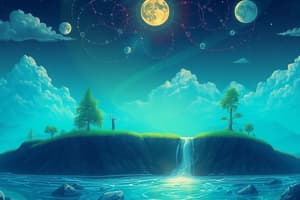Podcast
Questions and Answers
What are the two components that chemicals circulate through in biogeochemical cycles?
What are the two components that chemicals circulate through in biogeochemical cycles?
- Only atmospheric components
- Nonliving components only
- Living components only
- Biotic and abiotic components (correct)
A biogeochemical cycle can only be gaseous.
A biogeochemical cycle can only be gaseous.
False (B)
What are the four major biogeochemical cycles discussed?
What are the four major biogeochemical cycles discussed?
Water, carbon, phosphorus, and nitrogen cycles.
What is the process called when liquid water changes to gaseous state?
What is the process called when liquid water changes to gaseous state?
A distinctive feature of the water cycle is that water is a ______.
A distinctive feature of the water cycle is that water is a ______.
What is the top of the saturation zone in the ground called?
What is the top of the saturation zone in the ground called?
What provides much of the energy required for evaporation?
What provides much of the energy required for evaporation?
Most of the adult human body consists of water.
Most of the adult human body consists of water.
What gas do plants take up from the atmosphere during photosynthesis?
What gas do plants take up from the atmosphere during photosynthesis?
What is a result of nitrogen fixation?
What is a result of nitrogen fixation?
Match the following processes with their respective cycles:
Match the following processes with their respective cycles:
Which gas is released into the atmosphere during the decomposition of organisms?
Which gas is released into the atmosphere during the decomposition of organisms?
What are fossil fuels formed from?
What are fossil fuels formed from?
Which of these gases are considered greenhouse gases?
Which of these gases are considered greenhouse gases?
The global climate has cooled since the Industrial Revolution.
The global climate has cooled since the Industrial Revolution.
What gas is converted to nitrates in the atmosphere?
What gas is converted to nitrates in the atmosphere?
What are the sources of ammonium?
What are the sources of ammonium?
Denitrification is the conversion of nitrate back to nitrogen gas.
Denitrification is the conversion of nitrate back to nitrogen gas.
What do plants use ammonium and nitrates for?
What do plants use ammonium and nitrates for?
What human activity significantly alters the nitrogen cycle?
What human activity significantly alters the nitrogen cycle?
What is the consequence of algae dying off in water bodies?
What is the consequence of algae dying off in water bodies?
Acid deposition only affects water bodies.
Acid deposition only affects water bodies.
What gases contribute to acid deposition from burning fossil fuels?
What gases contribute to acid deposition from burning fossil fuels?
How do humans increase the supply of phosphate in the environment?
How do humans increase the supply of phosphate in the environment?
What is usually a limiting nutrient for plants?
What is usually a limiting nutrient for plants?
Phosphate in marine sediments becomes available to producers on land without geological upheaval.
Phosphate in marine sediments becomes available to producers on land without geological upheaval.
Flashcards are hidden until you start studying
Study Notes
Biogeochemical Cycles
- Chemicals circulate through ecosystems via biotic (living) and abiotic (nonliving) components, forming biogeochemical cycles.
- Each organism utilizes atoms from the soil, atmosphere, or other organisms to build its body, returning them to the environment upon death.
Major Biogeochemical Cycles
- Four primary cycles: water, carbon, phosphorus, and nitrogen.
- Biogeochemical cycles can be categorized as sedimentary (like phosphorus) or gaseous (like carbon and nitrogen).
Water Cycle
- The hydrologic cycle is essential for all life, as most organisms rely on water, with adult humans composed of about 60% water by weight.
- Water is chemically synthesized and split during cellular respiration and photosynthesis.
- Evaporation transforms liquid water into vapor, while condensation changes vapor back into liquid.
- Water evaporates from land and plants (transpiration), and then precipitates as rain.
- The groundwater table indicates saturation levels beneath the surface, with water ultimately returning to the sea due to gravity.
Carbon Cycle
- Carbon dioxide (CO2) is exchanged between organisms in terrestrial and aquatic ecosystems and the atmosphere.
- Plants absorb CO2 and convert it into organic carbon through photosynthesis.
- Aquatic organisms utilize bicarbonate (HCO3−), which balances CO2 between air and water.
- Living and dead organisms store organic carbon, contributing to carbon reservoirs, including fossil fuels formed from organic remains millions of years ago.
- Excess atmospheric CO2 from human activity results from fossil fuel combustion and deforestation, impacting the greenhouse effect and contributing to global warming.
Greenhouse Effect
- Greenhouse gases, including CO2, nitrous oxide (N2O), and methane (CH4), trap heat in the atmosphere, leading to an increase in Earth’s average temperature.
- Global temperatures have risen by 0.6°C since the Industrial Revolution, with predictions of a 1.5–4.5°C increase by 2100 if emissions continue unchecked.
Nitrogen Cycle
- Atmospheric nitrogen (N2) constitutes about 78% of the air but is unusable by plants.
- Nitrogen fixation converts N2 into ammonium (NH4+), which plants can absorb and use.
- Certain cyanobacteria and bacteria in soil and legumes are responsible for nitrogen fixation.
- Nitrification involves converting ammonium into nitrates (NO3−), which plants can also utilize for growth and development.### Nitrogen Cycle
- Nitrogen gas (N2) converts to nitrates (NO3−) via high-energy reactions from cosmic radiation, meteor trails, and lightning.
- Ammonium (NH4+) sources include decomposition of organisms and animal wastes.
- Nitrifying bacteria in soil convert NH4+ to nitrite (NO2−) and then to nitrate (NO3−).
- Plants assimilate NH4+ and NO3− to synthesize proteins and nucleic acids.
- Denitrification is the process of converting nitrate back to nitrogen gas, reintroducing it to the atmosphere.
- Denitrifying bacteria in anaerobic environments like lakes and bogs facilitate this process.
- Human activities, particularly fertilizer production from N2, significantly disrupt the nitrogen cycle, nearly doubling fixation rates.
- Fertilizer runoff into waterways leads to excessive algal growth, potentially causing fish kills due to oxygen depletion when algae die and decompose.
- Acid deposition from nitrogen oxides (NOx) and sulfur dioxide (SO2) from fossil fuel combustion results in environmental damage.
Phosphorus Cycle
- Phosphorus trapped in ocean sediments is brought to land through geologic uplift.
- Weathering of rocks releases phosphate ions (PO3− and HPO4+) into the soil over time.
- Available phosphates become incorporated into plants, essential for molecules like ATP, DNA, and RNA.
- Phosphate is often a limiting nutrient in ecosystems, restricting population sizes due to its scarcity.
- Some phosphate drains into aquatic ecosystems, contributing to nutrient cycling.
- Phosphate in marine sediments is made available to land producers only after geologic upheaval.
- Human activities increase phosphate availability through mining for fertilizers and detergents.
- Fertilizer runoff, livestock waste, and sewage discharge lead to eutrophication, resulting in enriched waterways and potential ecological issues.
Studying That Suits You
Use AI to generate personalized quizzes and flashcards to suit your learning preferences.




